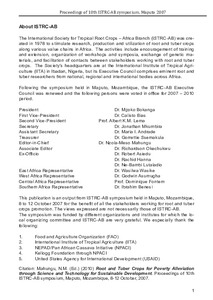| dc.contributor.author | Mhone, M.S. |
| dc.contributor.author | Mhone, T.A. |
| dc.contributor.author | Gondwe, T.N.P. |
| dc.contributor.author | Safalaoh, A. |
| dc.contributor.author | Mhone, A. |
| dc.contributor.author | Mahungu, N.M. |
| dc.contributor.author | Sandifolo, V. |
| dc.date.accessioned | 2019-12-04T11:11:00Z |
| dc.date.available | 2019-12-04T11:11:00Z |
| dc.date.issued | 2010 |
| dc.identifier.citation | Mhone, M.S., Mhone, T.A., Gondwe, T.N., Safalaoh, A., Mhone, A., Mahungu, N.M. & Sandifolo, V. (2010). Feeding and economic value of cassava starch by-products to growing fattening pigs. In: Proceedings of 10th ISTRC-AB symposium in Mozambique: root and tuber crops for poverty alleviation through science and technology for sustainable development, (p. 426-436), 8-12 October, Maputo. |
| dc.identifier.isbn | 99951-60-00-5 |
| dc.identifier.uri | https://hdl.handle.net/20.500.12478/2325 |
| dc.description.abstract | An experiment was conducted to evaluate the feeding and economic value of cassava starch by-products as source of energy in diets for growing fattening pigs. Cassava starch by-products were incorporated in the diets at 0 (treatment 1, control), 10 (treatment 2), 20 (treatment 3) and 30% (treatment 4). Each treatment had three replicates arranged as unbalanced incomplete block design. Pigs fed treatment 4 had the highest (p<0.05) feed intake (23.05), body weight gain (62.90) and growth efficiency (2.06) than those given treatment 1, 2 and 3 whose results were; feed intake (16.48, 10.49 and 8.02), body weight gain (42.77, 21.94 and 6.25) and growth efficiency (1.57, 0.74 and 0.26) respectively. Feed conversion ratios (3.25, 7.16 and 3.88) for treatments 1, 2 and 4 respectively, were similar but were different from treatment 3 which had a feed conversion ratio of 17.04. Back fat thickness (3.36, 1.50 and 4.65), for treatments 1, 3 and 4 respectively, were significantly (p<0.05) different. This study therefore, showed that replacement of maize with 30% cassava starch by-products in diets of growing fattening pigs improve feed intake, body weight gain, feed conversion ratio and growth efficiency than replacement of maize with 10% and 20% cassava by products. |
| dc.format.extent | 426-436 |
| dc.language.iso | en |
| dc.publisher | International Institute of Tropical Agriculture |
| dc.subject | Cassava |
| dc.subject | Cassava Starch |
| dc.subject | Byproducts |
| dc.subject | Feeds |
| dc.subject | Pigs |
| dc.subject | Malawi |
| dc.subject | Economic Value |
| dc.title | Feeding and economic value of cassava starch by-products to growing fattening pigs |
| dc.type | Conference Paper |
| dc.description.version | Peer Review |
| cg.contributor.affiliation | Lunyangwa Research Station, Malawi |
| cg.contributor.affiliation | Bunda College of Agriculture, Malawi |
| cg.contributor.affiliation | International Institute of Tropical Agriculture |
| cg.coverage.region | Africa |
| cg.coverage.region | Southern Africa |
| cg.coverage.country | Malawi |
| cg.authorship.types | CGIAR and developing country institute |
| cg.iitasubject | Cassava |
| cg.howpublished | Formally Published |
| cg.publicationplace | Ibadan, Nigeria |
| cg.accessibilitystatus | Limited Access |
| local.dspaceid | 92054 |
| cg.targetaudience | Scientists |

